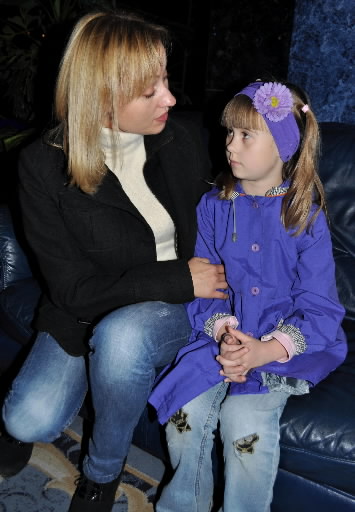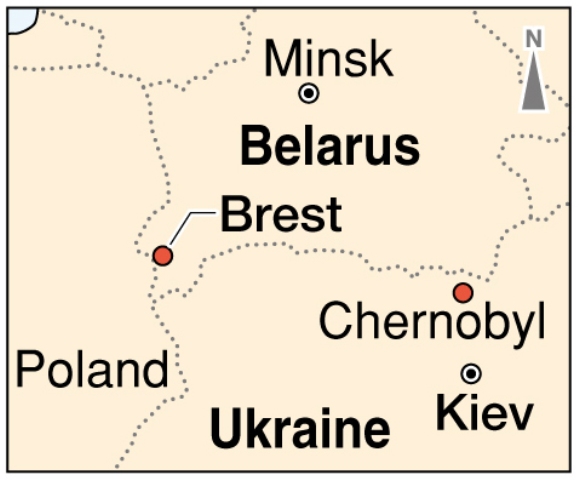Fukushima and Hiroshima: Lessons from Chernobyl, Part 6 [2]
Nov. 2, 2011
Article 2: Thyroid cancer
by Yo Kono, Staff Writer
Shipments of contaminated food cast long shadow
A surgical scar in the shape of a “U,” about 25 centimeters in length, is visible on the neck of Ludmila Ukrainka, 35. Ms. Ukrainka lives in the city of Minsk in Belarus. Both lobes of her thyroid gland were removed 19 years ago, after tumors developed on them when she was 15.
The loss of this secretory organ, which supports the body’s growth and metabolism, has led to the poor health she now suffers. “When I see the scar, it always reminds me of the accident,” Ms. Ukrainka said. To conceal her neck, she wears only clothing with a high neckline.
Thyroid cancer is cited as one of the health concerns wrought by the accident at the Chernobyl nuclear plant. The illness is said to be attributed to internal exposure to radioactive iodine taken into the body. The United Nations Scientific Committee on the Effects of Atomic Radiation has reported that about 6,000 people, the majority of them children, have developed this disease and 15 patients have died.
Contaminated food, including milk and mushrooms, caused this internal exposure to radiation. The government of the former Soviet Union took too long to control the shipment and distribution of contaminated food and failed to pursue measures to alert the public to potential danger.
“In my case, I suspect the cause was wild strawberries,” Ms. Ukrainka murmured, casting her eyes down and placing a hand on her daughter’s shoulder. “I often picked them in the forest and ate a lot of them.” Back then she lived in a town that was one of the “hot spots,” where the level of radiation was particularly high compared to adjacent areas.
Japan placed restrictions on shipments
When it came to the accident at the Fukushima No. 1 (Daiichi) nuclear power plant, the lesson from Chernobyl concerning the danger of internal exposure to radiation was ultimately taken into account. One example is milk. Although the measure was instituted 11 days after the accident, the Japanese government ordered restrictions placed on shipments of milk. Satoshi Tashiro, 49, a professor at Hiroshima University’s Research Institute for Radiation and Medicine, said, “Because of this action, I presume that the incidence of thyroid cancer in Fukushima will be minimal.” He added, however: “I couldn’t affirm this, though.”
In October the Fukushima prefectural government launched ultrasonic examinations of the thyroid gland of approximately 360,000 Fukushima residents who were 18 years of age or younger at the time of the accident. The scale of these examinations is the largest of its kind ever undertaken anywhere. The examinations will then be given on a regular basis throughout the lifetime of this population.
Rise in cases of cancer several years after the accident
In the wake of the Chernobyl accident, the number of cases of thyroid cancer began to rise four or five years after the disaster. For Alesha Sviatshik, 25, a woman of Belarus, her cancer was detected when she was 19. This was 20 years after the accident. “I never imagined this would be my fate,” she said.
Ms. Sviatshik was still in her mother’s womb when the nuclear plant at Chernobyl failed. The half-life of a radioactive substance refers to the period of time it takes for its radioactivity to fall to one-half its original value. In the case of iodine, that half-life is short, only 8 days. Whether or not exposure to radioactive iodine was the cause of Ms. Sviatshik’s cancer has not been confirmed.
“The mechanism of thyroid cancer has not been fully clarified,” said Yuri Galin, 42, vice president of the Medial Reeducation Academy, a national research institute in Belarus. Dr. Galin stressed, “It can’t be said that the people of Fukushima won’t develop this form of cancer, too. It’s important to conduct examinations with a watchful eye.”
At one medical institution in the city of Brest, located in southwestern Belarus, about 30 people were in the waiting room and out in the corridor, there to receive an examination for thyroid cancer. They all looked uneasy as they waited for their names to be called. When their turn came, they underwent an exam in which cells from their thyroid gland were extracted using a syringe. In this way, at least two people were confirmed to have developed thyroid cancer.
(Originally published on October 28, 2011)









